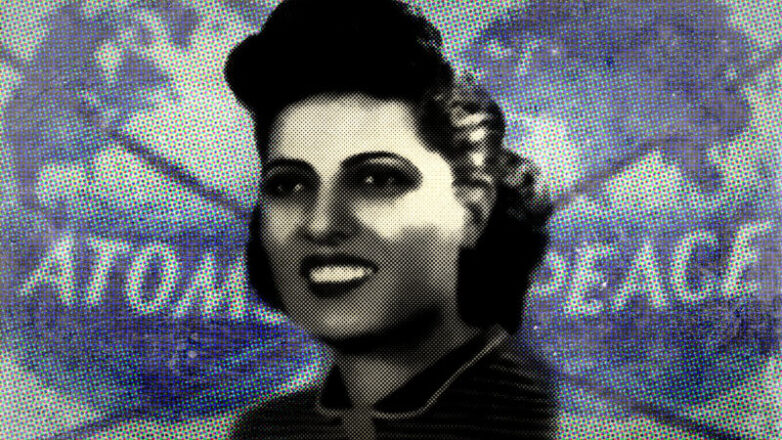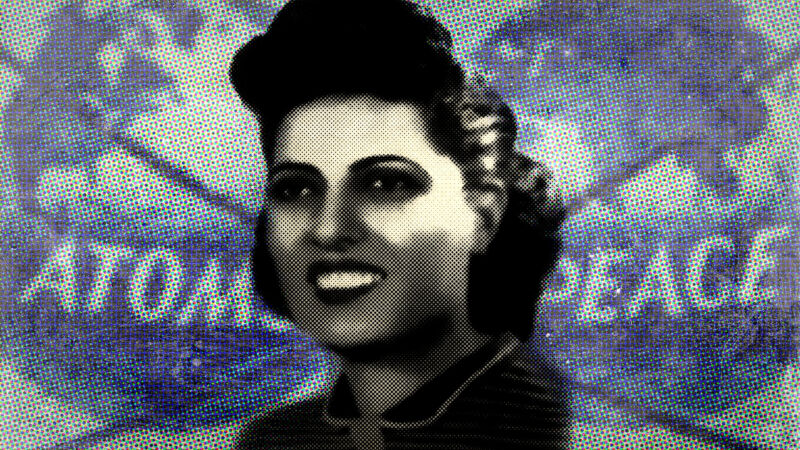

Science and the technology it enables have always had a close connection with warfare. But during World War II, the destructive power of science was raised to new levels. As the threat of nuclear holocaust remained high throughout much of the Cold War, many in the public became concerned about their governments and the scientists who worked for them.
Many physicists realized that the genie was out of the bottle and recognized this distrust – or shared it. They created conferences or drafted policies to distance themselves from the nuclear threat. Others tried to spin nuclear technology more positively by focusing on the advances it enabled in energy or medicine. These efforts to reassure the public have continued today as scientists have taken similar measures for newer, potentially destructive technologies such as gene editing.
During World War II, Sameera Moussa, a relatively unknown Egyptian physicist, was one of the key people who tried to use atomic energy for good and made efforts to involve the public in that choice. Her work makes her a worthy role model for women and physicists worldwide, but she is largely unknown because her crusade for peaceful nuclear power would eventually cost her her life. Moussa was murdered at the age of 35 in a case that remains unsolved today.
Moussa’s early life and work with X-rays
Unfortunately, of the few records of Moussa’s life today, most are second-hand accounts or retellings of hearsay, making it difficult to trace her movements. She was born just north of Cairo on March 3, 1917. There is not much information about her childhood, but we do know that her mother died of cancer when Moussa was young. Her mother’s death would later inspire Moussa to study the use of radiation for cancer treatments. After her mother’s passing, Moussa and her father moved to Cairo, where her father established a hotel business. Some reports claim that Moussa’s father was a political activist, which may have inspired her later activism.
After success as an elementary and high school student, Moussa was accepted into Cairo University’s nuclear physics program, specifically focused on X-rays. Moussa could not have chosen a better field of study for the 1930s. X-rays became a popular tool for many hospitals and private practices, as it was then the norm for every facility to own an X-ray machine. In the United States, this promoted the formation of many organizations of radiology technicians and radiology-focused journals. Europe had an even longer history of X-ray development, as a scientist Marie Curie transported a mobile X-ray machine across the battlefields of World War I.
Like others before her, Moussa studied radioactive isotopes used to create medical images, a technique still used today. Her doctoral work caught the eye of Cairo University’s Chair of Science, Moustafa Mousharafa, who being recruited Moussa as lecturer. Later she became an assistant professor there and apparently became the first woman anywhere to teach in a university setting while pursuing her Ph.D. It was an almost impossible feat, as British and other foreign professors still dominated many Egyptian universities. Still, Moussa achieved a string of firsts.
Finding a formula for nuclear fission
Thanks to her reputation, Moussa was able to travel to Britain in the mid-1940s, where she completed her Ph.D. There she collaborated with several researchers to make further advances in nuclear physics. Along with his colleagues, Moussa developed an equation that helped explain how to generate X-rays from cheaper metals like copper, which could help make medical imaging more affordable. According to a 2022 Inside Arabia In the article, Moussa’s “research laid the foundation for a revolution and the affordability and safety of nuclear medicine.”
Excited by his discovery, Moussa kept his focus on medical applications, including shortening patients’ X-ray exposure times and making X-ray procedures more mobile and flexible. She said, “I will make nuclear therapy as accessible and as cheap as aspirin.” Still, she was concerned that this formula could be twisted to create something far more deadly: an atomic bomb.
Although no records indicate Moussa’s whereabouts during the bombings of Hiroshima and Nagasaki in 1945, it is likely that she was still in the UK. Moussa saw the potential use of nuclear energy for warfare and organized Atomic energy for peace conference in Great Britain under the slogan “Atoms for Peace” (a slogan later adopted by President Dwight Eisenhower in a 1953 speech). The meeting was well attended by her fellow researchers and led to recommendations to create a committee to monitor nuclear hazards, such as nuclear weapons.
Promote a false peace
Because of the devastation of the atomic bombs, there was a widespread fear of nuclear power. To quell the hysteria, the American and British governments tried to create a positive story. For example, they encouraged researchers to host conferences, such as Pugwash Conference in Canada, where scientists from the former Allies and Axis countries gathered for the first time since the war to discuss the future of nuclear weapons. In addition, governments worldwide encouraged scientists to promote nuclear power’s benefits and avoid technical, scientific jargon, as it could create further confusion among the public.
But the West realized the potential power of nuclear energy; it wanted to exploit it and prevent its opponents from doing so. To hide their intentions, the United States and Britain used “peaceful atomic” as a political tool to broker exclusive agreements with countries that had uranium deposits, such as Brazil and South Africa. In his book, The wretched atomDr. Jacob Darwin Hamblin of Oregon State University writes that the idea of the peaceful atom “exploited social aspirations, anxieties and environmental vulnerabilities, particularly in the developing world.”
Since these deals often traded weapons for uranium, associating the label “peaceful atom” with them was a pure sham. To avoid a race for uranium, the US (and later Britain) downplayed its importance, citing medicine and agriculture (such as pest control or sterilization) as crucial benefits. Scientists using the “peaceful atom” narrative provided cover for the uranium race and helped create a high-pressure, high-secrecy environment within government research facilities around the world as many countries began stockpiling nuclear material.
Moussa found herself in the middle of this new arms race when she made an early visit to the United States The 1950s, after being awarded one of the first Fulbright fellowships. She went to the University of Missouri to continue her research. From there, Moussa contacted several scientists in California to visit some of their nuclear power plants. Moussa wrote in a letter to his father: “I have been able to visit nuclear power plants in America, and when I return to Egypt I will be of great service to my country and able to serve the cause of peace.”
But before she could even set foot on the premises, Moussa found herself the focus of a security investigation. Since she was not a US citizen, many wondered if she was a spy trying to get information about top-secret US nuclear research for other countries. While Moussa was eventually cleared of suspicion, the government offered her US citizenship to avoid future trouble. She declined the offer, proverb, “Egypt, my homeland, is waiting for me.” In the end, this refusal may have cost her her life.
An unsolved murder
In 1952, Moussa visited a nuclear research facility near the University of California, Berkeley. Although there are several stories about what happened next, the general themes of these stories are the same. One evening, Moussa received an invitation to a dinner or a power plant visit (depending on the source) and asked to be driven to the event. She jumped into the back seat of the car and the driver sped off. However, it took a sharp turn at one point on the Pacific Coast Highway. Her driver suddenly swerved the car off the road and jumped out as the car plunged 40 feet off a cliff, killing Moussa. Some accounts claim that another vehicle forced the crash, but in both cases the case raised suspicion among police and national authorities.
Since the driver was never identified after the crash and the invitation given to Moussa turned out to be fake, many speculated that Moussa was murdered. Some rumors suggested that the Israeli intelligence agency Mossad was behind the death and was trying to stop Egypt from creating nuclear weapons. Other experts suspected that this could be the work of the CIA, as they believed that Moussa had seen too much during his visit. Her murder remains unsolved to this day.
While we may never know what happened, Moussa’s tragic death at age 35 shows how important she was at the time—in that someone saw her as a threat.
Moussa was among a number of people involved in the “Atoms for Peace” cause who died prematurely. The legacy of “Atoms for Peace” has been seen as producing mixed results, as the public never fully regained its trust in scientists. Despite many efforts since then, this distrust persists, from pure science denial to skepticism about vaccines and climate change.
A rediscovered role model
Today, Moussa is a role model for young female researchers worldwide, although she is best known by Egyptian students. As Dr. Ruth Mateos de Caboprofessor at the University Foundation San Pablo CEU, explains: “In general, role models can inspire, empower and support students who share their background by showing them what is possible and how to achieve it. Therefore, the more similar the background, the easier it becomes for students to engage with them and even see in their shoes. For example, having teachers who share their racial/ethnic background has been found to increase student academic achievement, motivation, and expectations.”
In her research, Mateos de Cabo has found that female role models of similar ethnicity can challenge traditional gender roles while inspiring young women. This is especially important for the field of physics, where currently only 20 percent of scientists in the United States are women, and some experts predict that it will be until the next century before half of physics scientists are women. This inequality makes finding role models to inspire the next generation even more important – and even more difficult.
“One of the main challenges in implementing female role models in the educational system and the scientific community is the lack of female representation in these fields,” explained Mateos de Cabo. “According to UNESCO, only 35 percent of STEM students globally are women, and they occupy only 28 percent of research and development jobs worldwide. This lack of representation makes it difficult for female students to identify with successful women in their field, making challenging them to see themselves as potential role models.”
Raising awareness of stories like Moussa’s could potentially increase the representation of women from all backgrounds. “She was a brilliant, patriotic and powerful Egyptian woman,” explained Egyptian scholars Maha Metawei at the Electronics Research Institute in Cairo. “We are all very proud of her. We see her as a beautiful Egyptian face, a brilliant mind who laid the foundation for cancer treatment with radiation, and a loyal Egyptian who insisted on returning home with her research findings after her fellowship in the United States. her speaking out against nuclear weapons at a time when people were terrified of nuclear threats.”
Know Hughes-Castleberry is a science communicator at JILA (a joint research institute for physics between the National Institute of Standards and Technology and the University of Colorado Boulder) and a freelance science journalist. Her main writing focuses on quantum physics, quantum technology, deep technology, social media and the diversity of people in these fields, particularly women and people from ethnic and racial minority groups. Follow her on LinkedIn or visit her website.
#physicist #Sameera #Moussa #role #model #target #Ars #Technica